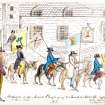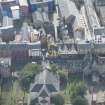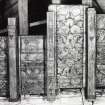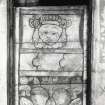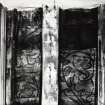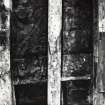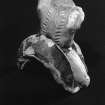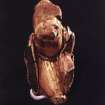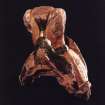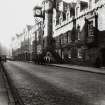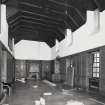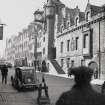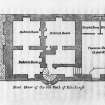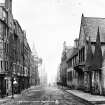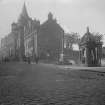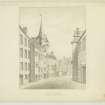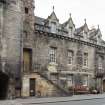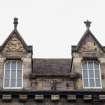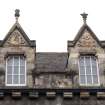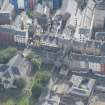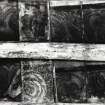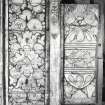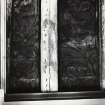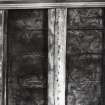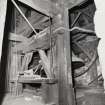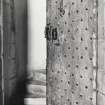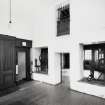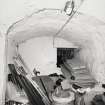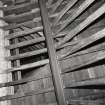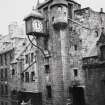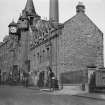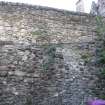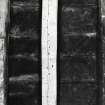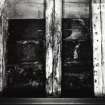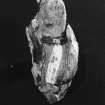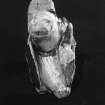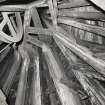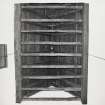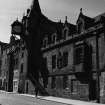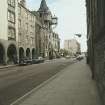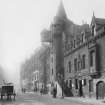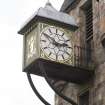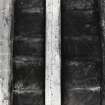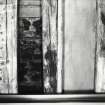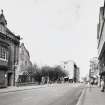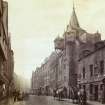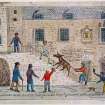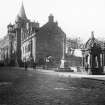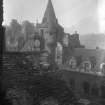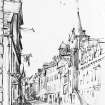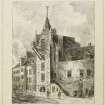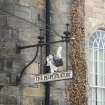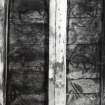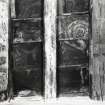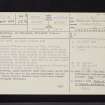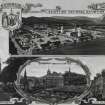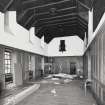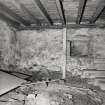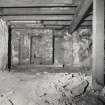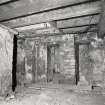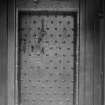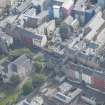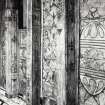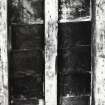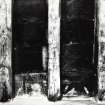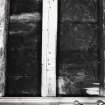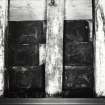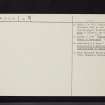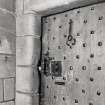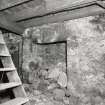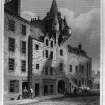Edinburgh, 163 Canongate, Canongate Tolbooth, City Museum
Museum (20th Century), Tolbooth (16th Century), War Memorial (20th Century) (1920)
Site Name Edinburgh, 163 Canongate, Canongate Tolbooth, City Museum
Classification Museum (20th Century), Tolbooth (16th Century), War Memorial (20th Century) (1920)
Alternative Name(s) Burgh Of Canongate War Memorial Plaque
Canmore ID 52527
Site Number NT27SE 62
NGR NT 26418 73792
Datum OSGB36 - NGR
Permalink http://canmore.org.uk/site/52527
First 100 images shown. See the Collections panel (below) for a link to all digital images.
- Council Edinburgh, City Of
- Parish Edinburgh (Edinburgh, City Of)
- Former Region Lothian
- Former District City Of Edinburgh
- Former County Midlothian
NT27SE 62 26409 73796
(NT 2641 7379) Canongate Tolbooth (NR)
OS 1/1056 plan, (1854)
Canongate Tolbooth was built in 1591, following conventional lines, as it contains a hall, which served as a council room and courthouse, raised upon an undercroft, and a tower which projects at the W end, for the bell-chamber. The turrets of the tower, and bell-chamber have ornamental shot-holes. The front of the main block was extensively restored in 1879.
RCAHMS 1951.
The building is as described in previous information.
Visited by OS (S F S) 4 November 1975.
A four-storey, angle-turreted tower with panel dated 1591. Adjoining on the east is the near-contemporary two and a half storey Council chamber block with ariel window and re-aligned forestair.
J Neild 1812; G Stell 1982.
Excavation of most of the cellar area took place in advance of the lowering of the floor. Superimposed floor layers to a maximum depth of 67cm were removed, and a number of cut features of varying date were located. These included construction pits, a clay-lined water-tub and a wooden tub sunk into the floor. Part of a stone drain survived at the lowest level. Pottery ranged from post-medieval green-glazed to 19th century, and large numbers of clay pipe fragments were recovered. Part of a mounted figure in glazed ceramic was found. This has been dated to the later 16th century and may belong to either an aquamanile or a roof-ornament.
N M M Holmes 1988.
(Formerly scheduled as Edinburgh, Canongate, tolbooth). Descheduled.
Information from Historic Scotland: Certificate of Exclusion from Schedule dated 19 November 2003.
NT27SE 62 26409 73796
INFORMATION TAKEN FROM THE ARCHITECTURE CATALOGUE:
Built 1591. Restored 1879.
REFERENCE:
EDINBURGH PUBLIC LIBRARY
Somerville's 'Sketches of Old Buildings etc' - 2 original sketches (1817)
Historical filed -'The Cross of Edinburgh'
Publication Account (1951)
105. The Tolbooth, 163 Canongate.
This interesting survival of a type of municipal architecture which came into use in the latter part of the 16th century, and was once fairly common in Scotland, stands on the N. side of the street almost opposite Huntly House and immediately W. of the Church. It was built in 1591 and follows conventional lines, as it contains a hall, which served the dual purpose of Council Room and Courthouse, raised upon an undercroft, and a tower which projects at the W. end to accommodate the bellchamber.* The tower has a handsome front of ashlar, graced at the wall-head with turrets or ‘rounds’ corbelled out from the S. angles on either side of a clock which projects from the wall face on brackets; the clock itself is modern and replaces an ‘orlech’ or ‘knock’, dating from the 17th century, which was upheld at an annual cost of 16 pounds Scots (1). Both the turrets and the bell-chamber are pierced with ‘shot-holes’, which seem to be intended for ornament rather than for use; and they are covered with pointed roofs which are now slated but were originally laid with oak shingles. A vaulted pend in the base of the tower gives access to Tolbooth Wynd, which lies behind, and this was continued northwards without vaulting when later tenements came to be erected against the back of the building. Over the entry is a panel bearing the inscription S.L.B. / PATRIAE / ET POSTERIS 1591 set between an index hand and three conventional flowers which occupy the corners, the initials being those of Sir Lewis Bellenden, superior of the Burgh. The crest of the Burgh, a stag's head erased with a cross between the tines, appears upon a shield carved upon the lintel of a window immediately above. The tower contains four storeys above the pend, the upper three of which are gained from a newel-stair on the E.; and this, as well as the first floor, is entered from a forestair rising against the front of the main block within the re-entrant angle. The windows, where unaltered, have a bold quirked edge-roll.
The front of the main block, which is also of ashlar throughout, was extensively restored in 1879. Its original aspect is shown in Gordon's pictorial map of 1647; and from this it appears that the forestair originally extended at right angles to the main block, which had three storeys, the principal storey or first floor being defined by a string-course. The lowest floor is lit by four windows and had two entrances; the floor above had five windows, the easternmost being an oriel; while the attic is lit by four dormer windows with triangular pediments. The dormers have now been replaced, but the wallhead is set out on a corbelling of separate members which, like the present string-course a storey below, seems to be quite modern. The first-floor windows, including the oriel, still exist, but all have been considerably altered. Between the two in the middle appears an original moulded framework enclosing a modern panel, which bears the arms and motto of the Burgh with the date 1128, the year in which the Burgh was erected. The framework is surmounted by a contemporary pediment with thistle-shaped finials at the apex and sides; this exhibits a crown at the top and an inscription below reading I(ACOBUS) R(EX) 6 followed by the hexameter line IVSTICIA ET / PIETAS VALIDE** / SVNT PRINCIPISARCES ("Verily, Justice and Piety are the bulwarks of a prince.") On the ground floor the two windows at the W. end and the adjoining doorway are probably original, but the window and archway at the E. end are of more recent construction. The E. gable was originally a mutual one and consequently contains no openings. None of the openings in the back wall is original.
Apart from a vaulted cell at the S.W. corner, the ground floor has been entirely modernised. A cellar, entirely subterranean, underlies the W. end and is lit only by a small, grated window at the level of the street. The forestair gives access to a little lobby on the first floor, from which the newel stair and Council Room are both entered. The entrance-doorway of the stair bears an index hand and the legend ESTO FIDUS (" Be faithful ") on the lintel. The door itself is nail-studded and furnished with a wrought-iron risp and scutcheon plate. The first and attic floors of the main block have been thrown into one apartment, which has been modernised. The rooms in the tower are also modernised, with the exception of the bell-chamber.
BELLs. The bell-chamber contains two bells. The larger one, measuring 3 ft. 71 in. in diameter at the skirt and 2 ft. l10 in. in height, was recast in 1847. The smaller one, 23 in. in diameter at the skirt and 20 in. in height, bears the inscription IAN BVRGERHVYS§ MME FECIT SOLI DEO GLORIA ("Jan Burgerhuys made me. Glory to God alone"), 1608.
RCAHMS 1951
(1) Acts of the Baillies of the Canongate, 1652-77.
*By Act of Parliament every burgh was required to possess a bell-house and bell.
**This word may be intended for VALIDAE, in which case the motto would mean ‘Justice and Piety are the strong bulwarks of a Prince’.
§ On the Burgerhuys foundry see RCAHMS 1951 p.268
Publication Account (1981)
A tolbooth in the Canongate was in existence by 1477 (RMS, ii , 217) .The present attractive structure was built in 1591 on the site of a previous one. It contains a hall which in former days served the dual purpose of Council Room and Courthouse. Although the tolbooth was used as a prison until 1848 (Wright, 1974, 25), it would not appear that it was always a secure institutional deterrent. In 1654, several Scots prisoners of war effect.ed their escape from the building by rending their blankets and sheets into strips (Grant, 1882, ii, 31) The tolbooth, which now serves primarily as a museum, was also extensively restored in 1879.
Information from ‘Historic Edinburgh, Canongate and Leith: The Archaeological Implications of Development’ (1981).
Publication Account (1996)
An archetypal tolbooth in the external appearance of its tower and council-chamber block, this building 1 stands on the N side of the Canongate opposite Huntly House. To the W it adjoins a 17th-century house whose upper storeys are now incorporated in the Tolbooth museum, and its E gable was formerly abutted by a lower three-storeyed building which was removed about 1689 to create the Canongate churchyard. The projecting belfry-tower at the Wend, which is dated 1591, contains an arched pend opening into Tolbooth Wynd and is capped by a broached spire. The three-storeyed main block contains a first-floor hall, which served as council-room and court-house, over an undercroft which is itselfpartiy built above a cellar. A three-storeyed wing, gabled to the N, was built N of the tower, 'be way of addition to the tolbuith', in 1677. 3 The council-chamber block was extensively restored and altered in 1875 by R H Morham, City Superintendent of Works. The interior underwent further alterations in 1908, in 1952-4 when it was adapted as a museum, and again in 1988, and it retains few early features.
The S front of the main block measures 17.3m from E to W and it is 7.6m wide, while the tower, which projects 1.5m to the S, extends the frontage a further 4.7m to the W. The tower is, however, ofL-plan, with an E wing which is encased in the main block, and its N wall is 7.2m long. The masonry of the S wall of the main block is not bonded with that of the tower, and its thickness is less than 0.8m, compared with Im in the N wall and 1.1m in the tower itself. It is possible that the stairdoorway in the SE re-entrant of the tower was intended to be an external one, and that the S front, on its present alignment, represents a change of plan, but the stylistic character of both Canongate Tolbooth (No.11) from SE, c. 1900 parts, and their identical masons' marks, indicate that only a short space of time can have intervened. The tower and main block are ashlar-fronted, whereas the rear wall and the E gable, which was probably extensively rebuilt in 1690, are of rubble.
The tower rises through four storeys above the pend, the uppermost being the bell-chamber, and most of its windows have rounded arrises, although a small ground-floor opening and the much-renewed third-floor one have quirked edge-rolls. The barrel-vaulted pend has an inner arch, rebated for two-leaf doors, 2.2m from the street-frontage, and a wide relieving-arch in the E wall. It was extended in 1677, with a shallower vault, through the ground floor of the added N wing. Over the entry to the pend there is a panel bearing the inscription: SLB / PATRIAE / ET POSTERIS / 1591 ('S(ir) L(ewis) B(ellenden), For Native Land and Posterity'), set between an index hand and three conventional flowers in the angles. The window immediately above has a lintel which was moved from the main block in 1875 and is carved with a shield bearing the burgh crest, a stag's head erased with a cross between the tines. A vertical sundial below the second-floor window was removed some time before 1936. An ogival-roofed clock projects on a cantilevered platform reached from the bellchamber and supported on long double-curved iron brackets of about 1820. The present clock-casing is dated 1884 as is the mechanism, by James Ritchie and Son, which is housed in the belfry, but the clock replaces an 'orlech' or 'knock' , dating from the 17th century.
At the SE and SW angles of the bell-chamber there are angle-rounds, with cable-mouldings in the highest courses of corbelling. These turrets and the bell-chamber are equipped with quatrefoil and plain gun-ports, presumably ornamental in function, and they have conical slated roofs which were originally laid with oak shingles. The spire, which was also shingled, has four small timber lucarnes at the base. The E wing of the tower was originally gabled, and the crow-steps of the N half-gable remain, while a cavetto skewputt from the former S half survives at the third stage above the entrance doorway. The small lean-to room above this level probably dates from 1698, when a stair to the bell-chamber was constructed in this area (infra). The main newel-stair, immediately to the N, had a rectangular cap-house which is partly preserved at the E wall-head of the tower and appears also to have been an addition.
The original appearance of the main block is shown in Gordon of Rothiemay's map of 1647. A forestair rose at right angles to a door in the SE re-entrant of the tower; the lowest floor was lit by four windows and had two entrances; the principal or first floor, which was defined by a string-course, had five windows, the easternmost being an oriel; and the attic was lit by four triangular-pedimented dormer-windows.
Externally, the 1875 restoration of the upper levels involved the creation of a new steeply-pitched roof, a corbelled parapet and four pedimented dormers in place of three hipped ones. The large first-floor windows were extensively renewed at the same period, although early photographs show that the doublesaw-tooth frame and the roll-moulded daylight of the oriel, and the broad hollow chamfers of the other windows, reproduce their original forms. Between the two central windows there is a moulded frame containing a panel (renewed in metal) with the arms and motto of the burgh and the date 1128, the foundation-date of Holyrood Abbey. The pediment above the frame has thistle-shaped finials and contains a crown above the inscription: I(ACOBUS) R(EX) 6 IVSTICIA ET / PIETAS VALIDE / SVNT PRINCIPIS ARCES (,Justice and piety are truly the bulwarks of a prince'). The forestair now rises along the S wall to a doorway whose chamfered jambs have been heavily renewed but retain some early sharpening marks. At ground-floor level a pedimented porch of early 19th century date below the oriel window, and a doorway at he E end, were replaced in 1875 by an archway for the 'fire engine station', and this in turn by a segmental-headed doorway in 1954. The two windows and adjacent doorway at the Wend probably occupy original positions, but have been renewed.
None of the openings in the back wall is original, but the W jamb of a tall blocked opening is visible E of the first-floor E window, and the relieving-arch of a former doorway survives above the ground-floor E window. The E gable-wall, which was at first a mutual wall with the adjacent property, contains no original openings, but there is a blocked one at the centre at ground-level. The mural monument of Lord Provost George Drummond (d.1766) is built into this wall, and the reredos monument of the economist Adam Smith (d.l790) is set against the N wall.
Internally, except for a vaulted cell in the S part of the tower, the ground floor has been modernised. A subterranean cellar underlies the Wend of the main block and is lit by a small grated window at street-level. An excavation in this area revealed remains of a shallow, stone-built drain. The first floor entrance-doorway opens into a small lobby, from which the council-room and the newel-stair to the upper levels of the tower are both entered. The stair-doorway bears an index hand and the inscribed legend ESTO FIDUS (' Be faithful') on the stone above the lintel. The door itself is nail-studded and retains a wrought-iron risp and escutcheon plate. The attic floor of the main block was removed in 1875 to form a heightened first-floor room whose inserted W gallery has itself subsequently been removed. The pine panelling in this main hall, which was installed in 1954, came from demolished houses in the area, and the 18th-century fireplace with elaborate plaster overmantel, concealed behind modem panelling in the E wall, came from Craig's Close. The upper rooms in the adjacent house, which are entered from the tower, contain a poorly-preserved early 17th-century ceiling with painted beams, and fireplaces of 18th-century character.
With the exception of the bell-chamber, the main rooms in the tower, which contained prison-accommodation, have also been modernised. In 1698 Edinburgh town council ordered 'that a trap stair be made throw the two studies at the tolbooth yeat (entrance) for ringing the bells that the prison may not therby be troubled or endangered'. This appears to refer to the small rooms in the two storeys above the main entrance, and these rooms, with an upper storey which was probably added at this time (supra), retain traces of the newel-stair that was then inserted. The spire and bell-chamber retain early timbers in the roof-structure and the two superimposed bellframes. The larger of the two bells, measuring 1.11m in diameter and 0.86m in height, was recast in 1847. The smaller one, 0.58m in diameter and 0.51m in height, bears the inscription: IAN BVRGERHVYS ME FECIT SOLI DEO GLORIA 1608 C'Jan Burgerhuys made me. Glory to God alone').
HISTORY
The burgh of Canongate was originally dependent on the abbey of Holyrood, by a grant from the founder, David I (d.1 153).I) The earlier tolbooth, which probably occupied the same site, was referred to in 1477 and was repaired in 1572-4. Plans for funding the building of the existing structure were in hand even before Canongate's erection in 1587 into a burgh of regality under Sir Lewis Bellenden, the justice-clerk. In 1590 Sir Lewis and the burgh council represented to the Privy Council (of which he was a member) that 'the hous of justice, uthirwayes callit the tolbuith of the Cannogait, is altogidder becum ruynous ', and that they had begun a sufficient house 'with strong wardis ', which was 'grite and sumptuus'. A tax of 2,000 merks was granted, to be levied equally on the burgh and the associated barony of Broughton, and the burgh and barony courts continued to be held in the tolbooth until the 19th century. The superiority was acquired by the City of Edinburgh in 1639, and Canongate was finally amalgamated with the city in 1856.
The wing to the N of the tower was added in 1677, and throughout the late 17th and 18th centuries repairs of varying extent were undertaken. Specific mention was made of repairs to the stair in 1678, to windows and roof in 1689, to the gablewall 'lately fallen ' in 1690, to the area around the caphouse on the N side in 1694, to the stair, chimney-heads, hearths in the 'woman house', toilets, roof-coverings, belfry trap-stair, and the causeway of the close in 1698.
At first the tower alone served as the prison, but by 1689 it appears that part of the top floor of the main block housed female prisoners. As described in 1837, the prisonaccommodation was spread through eight heated rooms, one 'large' and the others 'small '. By this period, its use was confined to debtors and, after a period of disuse, the building was re-opened as a debtors' prison for the whole of Edinburgh in 1842, continuing as such until 1848.
After the end of the burgh 's separate status in 1856 parts of the building continued to serve local government functions, and the ground floor housed a police station and the local fire engine. The main hall became a literary institute, with a library in adjacent rooms, and a gallery was installed in the hall in 1908. The tolbooth was adapted by A G Forgie, city architect, in 1952-4, for exhibition use by Edinburgh City Museums, and in 1989 the Peoples' Story Museum was opened.
Information from ‘Tolbooths and Town-Houses: Civic Architecture in Scotland to 1833’ (1996).










































































































